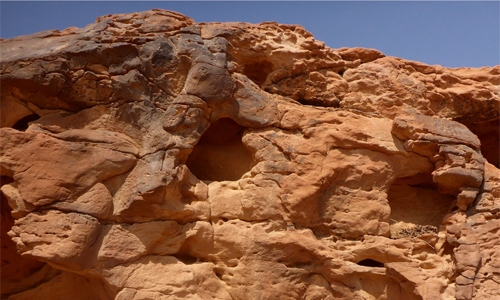Ancient artists carved camels in Saudi desert’s stone
Some 2,000 years ago, perhaps, ancient artists in the Arabian desert climbed tall rock outcrops and carved life-size camels into the stone.
Now, archaeologists exploring a site in northwest Saudi Arabia have discovered about a dozen of the humped sculptures. Although camel art has been found in other parts of the Arabian Peninsula, the newly uncovered engravings at the so-called “Camel Site” are stylistically unique.
The findings, which were reported Tuesday, could help provide insight into the history and development of rock art on the Arabian Peninsula.
“This is a major new discovery and in some ways a completely new type of rock art in Saudi Arabia,” said Maria Guagnin, an archaeologist from the Max Planck Institute for the Science of Human History who was not involved in the study. “The naturalistic, almost three-dimensional depictions are unlike anything else I’ve seen before and highlight the skills of their prehistoric engravers.”
Though much of the artwork is damaged from erosion or vandalism, the parts still visible suggest careful attention to detail. Sometimes the camels were carved alongside other beasts of burden, like donkeys.
In one rock panel there is a camel lying on the ground with its head tilted toward a donkey that is on its feet. The two are nearly touching.
“It raises its head to the head of the donkey, like Michelangelo in the Vatican — it’s the connection of two species,” said Guillaume Charloux, an archaeologist at the French National Center for Scientific Research and lead author on the paper, which appeared in the journal Antiquity. “To me, it’s a real piece of art.”
Dr. Charloux along with Hussain al-Khalifah from the Saudi Commission for Tourism and Heritage, led a team to explore the site in Al Jawf.
“When we arrived at the site, we were astonished,” said Dr. Charloux. The team conducted three short visits in 2016 and 2017. They found 11 camels, two donkeys and one unknown horse-like animal.
Despite their detailed artwork, the ancient artists left very few inscriptions or pieces of writing behind unlike at many other rock art locations.
That left the team with many unanswered questions, like who carved the sculptures? How did they carve them? And why camels?
Dr. Charloux suspects the engravers were influenced by Nabatean art, which came from an ancient nomadic people in the area, as well as the Parthians from what is now Iran. The Camel Site, he said, may have served as a border that signalled the edge of the Nabatean territory. It also could have been a rest stop for caravans crossing the desert to trade, or a spot to worship.
Dr. Charloux said based on its similarities to other works, it most likely dated to about 2,000 years ago. But the site is currently on private land that has been damaged by bulldozers, and it is difficult to scientifically date.
Laila Nehme, an archaeologist also from the French National Center for Scientific Research but not involved in the paper, said the work was unique because it was carved in relief, but added that she wasn’t ready to associate the work with the Nabateans or any other group in the region.
Peter Magee, an archaeologist from Bryn Mawr College in Pennsylvania said the finding shows the ingenuity of those who lived in ancient Arabia. But he pointed out that without scientific dating, the findings were tentative.
“An even earlier date for these amazing sculptures cannot be ruled out,” Dr. Magee said.
Related Posts


